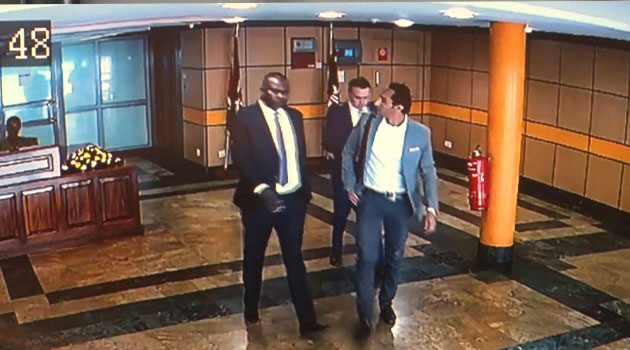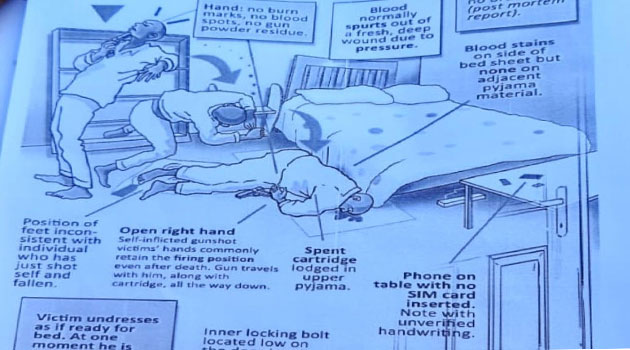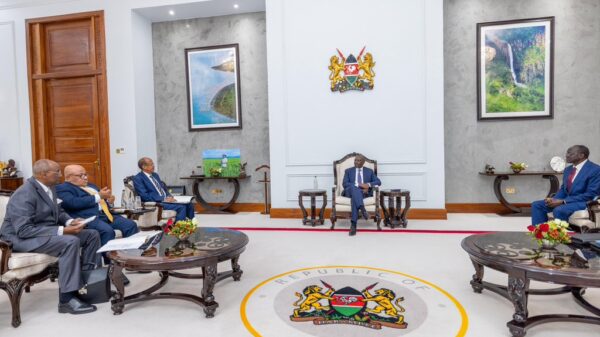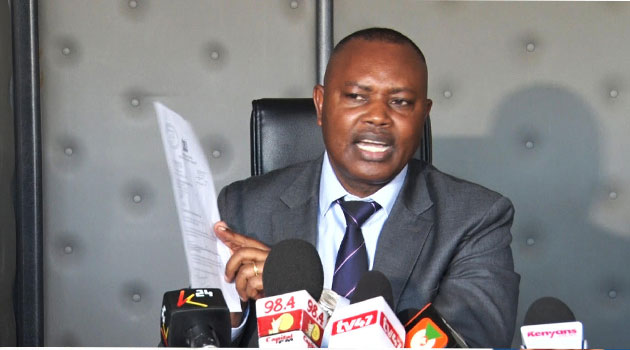
NAIROBI, Kenya, Mar 6- Slain Sergeant Kipyegon Kenei acted as a link between unknown officials at the Deputy President William Ruto’s office and former Cabinet Secretary Rashid Echesa, according to new evidence gathered by detectives.
On the day Echesa, two foreign arms dealers and a ‘military general’ visited Harambee House Annex, Kenei was captured on CCTV footage released to the public on Thursday, receiving and making calls most of the time.
From the time they entered Annex and to when they left, CCTV footage shows it lasted 1hr, 22 minutes and 59 seconds.
From the footage, which was released by the Director of Criminal Investigations George Kinoti, the Kenei who was dressed in a black suit first received Daniel Otieno Omondi, the man who played the role of a Military General in a deal to swindle polish arms dealers in a Sh39 billion deal in which they received Sh11.5 million.

Echesa, Omondi and two others are out on bond after facing charges of obtaining money by false pretense among other charges.
Other than ushering Omondi to the VIP’s lift, then to the boardroom, at some point, Kenei can be seen receiving a call and then handing it over to the fake military General.
“It leaves no doubt of the involvement of the deceased person in the said cartel,” the DCI said, concluding, “he was murdered in cold blood.”
Kenei’s body was discovered in his house two days after failing to report to work, at a time he was required to record a statement with detectives at the DCI Headquarters on activities of the day Echesa and the white men visited the DP’s office.

The body had a gunshot wound in the neck, exiting through the head, with is pistol lying next to him what Kinoti described as a stage-managed suicide scene.
“The people who killed him were determined to make it appear like a suicide because there was even a note on the table but the handwriting is not his,” he told reporters watching CCTV at his packed boardroom in Mazingira House, the DCI Headquarters where he was accompanied by Homicide and Forensic experts handling the matter.
What is it that Kenei knew that warranted his elimination?
While his phone was recovered, the DCI said it was had no data, raising concerns on why a person committing suicide would bother to destroy evidence?
And according to the homicide detectives, it is entirely linked to Echesa’s case.
The DCI, during an interview on Thursday, gave a chronology of events, detailing Kenei’s last minute.
-Tracing Kenei’s last moments-
On February 18, the DCI summoned all officers who were on duty at the DP’s office on February 13- the day Echesa visited the office- for an interview and statement recording.
“They were all assembled including the deceased on the same day and informed to appear at DCI headquarters the following day,” he said.
But Kenei did not report to work the following day, February 19.
The DCI said, “as it was expected, his superiors did not endeavor to find out where he was and neither did they visit his residence to inquire his whereabouts.”
And while the DP’s office penned two letters to the Inspector General of Police over “security breach in Harambee House Annex building” the DCI noted that “it is only Kenei who may have breached security protocol.”
It is on February 20 that his body was found in his bedsitter, within Villa Franca estate in Imara Daima.
-Crime scene forensic examination-
Kenei was found with pajamas and had no shoes.
The bed was neatly spread with no sign of any disturbance, “meaning he must have been standing when removing shoes.”
His room did not have any other place to sit on other than his bed.
The DCI noted that “nothing explains why he could strain to do all this avoiding an easier way of sitting and being comfortable to remove shoes and socks to change into pajamas.”
This, he said, can only suggest that the bed “if there was any disturbance, it was deliberately made after the murder.”
Homicide detectives did not find contact transfer stains on the bed cover, there was no back spatter visible on the firearm.
His firearm was used to discharge the single bullet that claimed his life.
“On visual examination, the firearm lack blood due to backward force of the bullet penetrating the body,” he said.
His phone was found to be in factor reset and Sim-Card missing.
-How comes no one heard a gunshot sound?-
Detectives are still wondering how a gunshot was not heard by a single person within the estate, including a house help who live in the main house and shared a wall with Kenei’s bedsitter.
Out of this, the DCI said, “we can only decipher a stage-managed scene determined by cold blood professional killers, thus the conclusion that the deceased was murdered.”
With his involvement in the Echesa case, the DCI said, the deceased “didn’t have a chance (to live).”
“It is evident that throughout he was receiving instructions or orders or directions from a certain source. It manifests that the stakes must be so high and adverse that it could be dangerous to expose the source,” Kinoti said, without releasing names of the possible suspect or suspects.
The motive, he said, is clear; “to safeguard, protect, insulate and or save the source from the adverse involvement and attendance consequences using the country military procurement process in the most deceitful and fraudulent manner.”
After a firing test conducted by detectives, it was established that even a shot muffled by cotton is audible from outside of Kenei’s house, including during the daytime when there is a lot of human activities.
As the investigations enter the second phase, the big question then is, who ordered or killed Kenei and was he killed somewhere else only for his body to be ‘planted’ at his house?



































